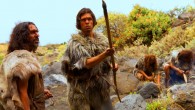How food production entered sub-Saharan Africa some 5,000 years ago and the ways in which herding and farming spread through the continent in ancient times has long been a topic of archaeological debate. Now a study led by Stony Brook University, Saint Louis University and Harvard Medical School scientists is providing some answers to these questions. Prehistoric rock paintings in Manda Guéli Cave in the Ennedi Mountains, Chad, Central Africa. Image...



















